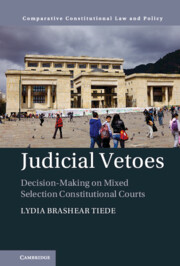Book contents
- Judicial Vetoes
- Comparative Constitutional Law and Policy
- Judicial Vetoes
- Copyright page
- Dedication
- Contents
- Figures
- Tables
- Acknowledgments
- 1 Introduction
- 2 The Implications of Mixed Judicial Selection on Decision-Making
- 3 Mixed Judicial Selection
- 4 The Chilean Constitutional Tribunal in Political Context
- 5 The Colombian Constitutional Court in Political Context
- 6 Determinants of Legal Invalidation by Constitutional Judges
- 7 Determinants of Legal Invalidation by Constitutional Courts
- 8 Weak Judicial Vetoes and Contentious Politics
- 9 Conclusion
- Appendices
- References
- Index
4 - The Chilean Constitutional Tribunal in Political Context
Published online by Cambridge University Press: 22 July 2022
- Judicial Vetoes
- Comparative Constitutional Law and Policy
- Judicial Vetoes
- Copyright page
- Dedication
- Contents
- Figures
- Tables
- Acknowledgments
- 1 Introduction
- 2 The Implications of Mixed Judicial Selection on Decision-Making
- 3 Mixed Judicial Selection
- 4 The Chilean Constitutional Tribunal in Political Context
- 5 The Colombian Constitutional Court in Political Context
- 6 Determinants of Legal Invalidation by Constitutional Judges
- 7 Determinants of Legal Invalidation by Constitutional Courts
- 8 Weak Judicial Vetoes and Contentious Politics
- 9 Conclusion
- Appendices
- References
- Index
Summary
The Chilean political and economic context dictates the rules and reforms which govern how the country’s Constitutional Tribunal and its judges operate as well as the types of laws it reviews. This political context is especially important for understanding the work of its Constitutional Tribunal as this court was created under General Augusto Pinochet’s military dictatorship, but has continued to operate to this day, through the country’s transition to democracy, several changes of elected governments, and several constitutional reforms. The chapter thus describes the institutions and legal and political developments under the junta as well as developments leading to Chile’s transition to democracy. The chapter follows with an analysis of the elected and non-elected branches in the democratic era prior to and after major constitutional reforms occurring in 2005. The final part of the chapter provides a rich description of the Tribunal itself.
- Type
- Chapter
- Information
- Judicial VetoesDecision-making on Mixed Selection Constitutional Courts, pp. 62 - 101Publisher: Cambridge University PressPrint publication year: 2022

